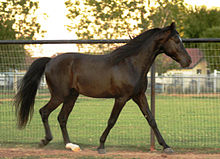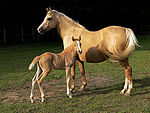- Missouri Fox Trotter
-
Missouri Fox Trotter 
Missouri Fox Trotter stallionDistinguishing features Unique gait Country of origin United States Horse (Equus ferus caballus) The Missouri Fox Trotter is an American breed of horse with a unique four beat gait. It was bred in the Ozark Mountain foothills, and used by settlers who valued its smoothness.
Contents
Breed characteristics
The breed is best known for its unique gait, known as the fox trot,a four-beat diagonal gait in which the horse appears to walk with its front legs and trot with its hind.[1] The gait, however, is not a mixed patter of footfalls, it has a clear pattern of diagonal foot movement where the front foot hits the ground split-second before the opposite rear foot. The head shakes in unison with the rhythm of the gait. The tail perfectly balances the movements of the head.[2] Because the horse has a four-beat motion rather than a two-beat trot, the gait is easy to sit. It is accompanied by an up and down head nodding. The horses, unlike some other gaited breeds, do not have high-stepping action, but rather a very smooth, comfortable ride. The fox trot can be maintained for great stretches of time, reaching speeds up to 12 mph. A Fox Trotter can also perform a speed fox trot which goes 12-18 mph.[3] The Fox Trotter also performs the flat-footed walk and the regular canter. Some Fox Trotters can also perform various lateral ambling gaits, such as the running walk or singlefoot. However, the fox trot is considered a more surefooted gait.[4]
The Missouri Fox Trotter is also known for its stamina and soundness. The horses have a willing and gentle disposition, and are very surefooted. They are generally medium-height, between 14.2 and 16.2 hands. They come in most equine coat colors, including most solid colors, and also including most pinto spotting patterns, but do not exhibit Appaloosa coloring.
Well-conformed horses have an elevated neck, head, and tail carriage, sloping shoulders, a short back with a rounded croup, and a slender body with a deep chest. They should have muscular and powerful hindquarters and legs.
History of the Missouri Fox Trotter
In the early 18th century, when pioneers came to the rugged foothills of Missouri from Tennessee, Virginia, and Kentucky, they soon realized that a horse with a natural four beat gait would be ideal for the rocky and forested land. Farmers selectively bred for the gliding fox trot by blending American Saddlebred, Standardbreds, and Tennessee Walkers with the Morgan, Thoroughbred and Arabian. An early breeding policy was to use horses that had reached fast running speeds.
Influential stallions include Brimmer, a Thoroughbred, Old Skip, a Morgan/Thoroughbred cross, and the two American Saddlebred stallions, Chief and Cotham Dare.
The settlers used the horses for working cattle ranches and for transportation of local officials, such as the sheriff and local doctor. In the early 20th century, the Fox Trotter survived because ranchers found it to be irreplaceable.
The breed association was formed in 1948, and was recognized in 1958 as the Missouri Fox Trotting Horse Breeders' Association (MFTHBA). In 1982, all horses were required to have at least one parent registered with the MFTHBA to be registered themselves. This changed in 1983, when both parents were required to be registered in order for the foal to be registered, and the stud book was thus closed.
The Missouri Fox Trotter today
Today, the breed is still popular in Missouri, as well as elsewhere. There are over 94,000 registered horses in the USA, Canada, Austria, and Germany. They are very popular with forest rangers and pleasure riders.
The horses are typically shown in western-style performance classes, Western and English Pleasure, show jumping, ranch, driving, versatility, and halter classes. Many are used for pleasure and trail riding. Their disposition is even and very gentle, and they are very versatile, which is why the breed is now being used for long-distance competitive trail riding. They are also increasingly used in the sport of driving.
When shown, horses are not allowed to have any artificial devices to accentuate their action, such as heavy shoes or chains around the fetlock. They have a natural tail set, and, unlike the American Saddlebred, are not allowed to be nicked. They are judged on their fox trot (50%), flat-footed walk (25%), and canter (25%) in the performance classes.
See also
References
- ^ "About Missouri Fox Trotting Horses" web page accessed May 24, 2008
- ^ Breed standard definition of the fox trot. Web page accessed May 24, 2008
- ^ http://www.foxtrotters.org/foxtrotting_horse_videos.htm
- ^ "Missouri Fox Trotters" Web page accessed May 24, 2008.
External links
- Missouri Fox Trotting Horse Breeders' Association Website
- Training the Missouri Fox Trotting Horse
- Missouri Fox Trotter Gaits
- Foxtrotters.org
Equine Equine science and
management
Equestrianism
and sportGlossary of equestrian terms · List of Equestrian Sports · Horse tack · Bit · Bridle · Saddle · Harness · English riding · Western riding · Driving · Horse training · Horse racing · Equestrian at the Summer Olympics (medalists, venues) · Horse show · EquitationEvolution and history Domestication · In warfare · In the Middle Ages · Horses in East Asian warfare · History of the horse in South Asia · Horses in the Napoleonic Wars · Horses in World War I · Horses in World War II · History of the horse in BritainHorse breeds, types
and other EquidaeList of horse breeds · Wild horse · Feral horse · Stock horse · Gaited horse · Draft horse · Warmblood · Sport horse · List of horse breeds in DAD-ISOther EquusHybridsCategories:- Horse breeds
- Horse breeds originating in the United States
Wikimedia Foundation. 2010.
